“Take a deep breath. Relax.” You’ve heard it before in stressful times, but do you know the root of this phrase? Yoga. The ancient practice of yoga is made up of three main ingredients: breathing, meditation, and asana (physical postures). Each factor alone has been proven to help relieve anxiety, but combining all three can increase the benefits.
About 3.3 million adults in the United States are affected by an anxiety disorder, and approximately one-third of the country’s annual $148 billion mental health care bill goes toward anxiety disorders. Patients cope with anxiety differently. One way that those who suffer from anxiety disorders (myself included) can learn to control their symptoms and lower their risk of panic attacks is yoga.
As a certified yoga teacher and a person who has suffered from panic attacks and an anxiety disorder, I encourage you to reach out. Speak with a doctor about your condition and ask a yoga instructor for assistance in learning postures beneficial to your goals. There are many types of yoga. Classes can range from fast-paced, sweat-inducing sequences, to relaxed, slow movements with meditative positions. If you choose to join a yoga class, inquire beforehand to decide if it is the right type of class for you.
Legs-Up-The-Wall Pose (Viparita Karani)
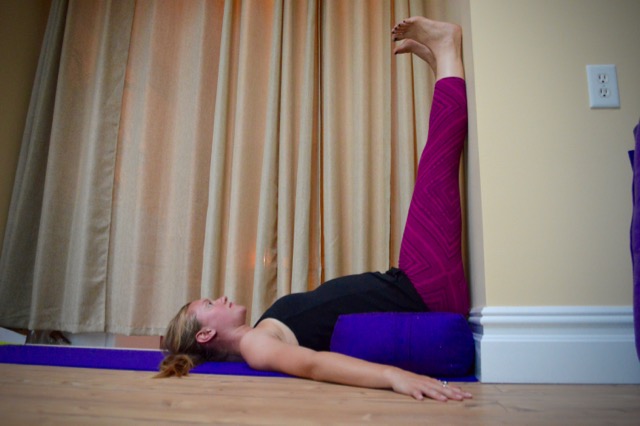
Jeanine Donohue, certified yoga teacher, in Legs-Up-The-Wall Pose with a bolster for an extra stretch (Katelyn Brush)
Reconnect with your inner child and lay your legs against the wall. Begin by lying back with your legs extended above you, parallel to the wall. Then, lean back for support while lifting your legs up the wall and adjusting your hips so that they are as close to the wall as you can get while keeping a comfortable, gentle stretch in the backs of your legs. Rest your back flat on the ground, perpendicular to the wall, with your chin tucked in toward your chest. Rest your eyes and focus on your breathing. Inhale. Exhale.
If your feet begin to tingle, bend your knees and bring the soles of your feet together, then slide your feet down the wall closer to your hips with your knees splaying outward. If your neck is tight or feels weak here, roll up a blanket and place it beneath your head for a little lift. To relieve lower back pain, lift your hips with pillows, blankets, or yoga blocks (you can improvise with textbooks!).
Benefits:
- Calms the mind while relieving stress, anxiety, and mild depression
- Relieves cramps and exhaustion in the legs and feet
- Relieves mild back and neck pain
- Gently stretches the backs of the legs, lower back, and neck
- Therapeutic for high blood pressure, arthritis, insomnia, headache, migraine, premenstrual syndrome, menstrual cramps, digestive problems, urinary disorders, and respiratory ailments.
Seated Forward Fold (Paschimottanasana)
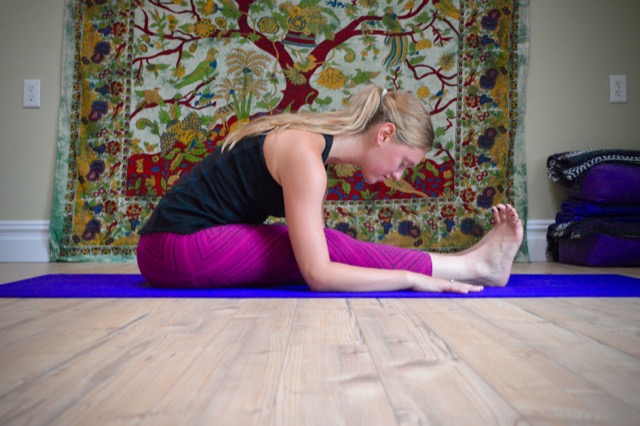
Jeanine Donohue, at It Takes a Village Wellness in Port Jefferson Station, New York (Katelyn Brush)
Get those sit bones planted onto your yoga mat (or towel or rug) by wiggling around until you’re in a comfortable seated position. Your legs should be together out in front of you, and the tailbone should be untucked to promote spine strength. Sit up tall, take a deep breath as you reach up high, and then exhale while folding your torso over the legs. Soften the knees if you have tight hamstrings. Don’t reach for your feet just yet! Walk your hands down the sides of your legs first so that you’re not rushing into the stretch. Synchronize your breathing with the stretch; as you exhale, go deeper. These tactics will allow you to lengthen your muscles and protect your lower back from injury.
Benefits:
- Calms the mind and relieves stress, anxiety, and mild depression
- Relieves mild back pain
- Stretches the backs of the legs, lower back, and spine
- Stimulates the kidneys and liver
- Therapeutic for digestive problems, sinusitis, high blood pressure, premenstrual syndrome, menstrual cramps, and insomnia.
Warrior III (Virabhadrasana III)
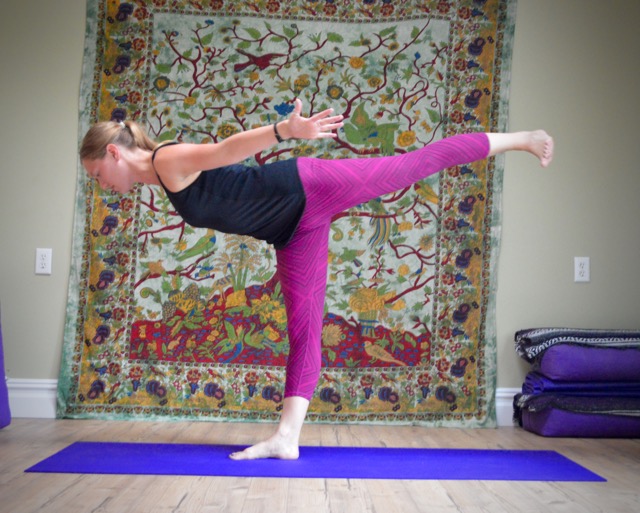
Jeanine Donohue, certified yoga teacher, practicing Warrior III at It Takes a Village Wellness (Katelyn Brush)
Postures that involve balancing focus the mind on the present moment because they require concentration if you hope to stay steady in the pose. There’s no space for worry here!
To enter this posture, come into a forward fold again, but this time, do so while standing up. To get started, step your “flying” foot back (choose either one to start) into a high lunge with the ball mounds grounded. The standing foot should be forward with the knee over the ankle, and the abdominal midline should be over the thigh. Rise up into a high lunge by engaging the core, bringing the palms to face one another, and reaching the fingertips toward the sky.
Slowly shift all weight into the standing foot (forward foot) while beginning to straighten the leg, hinge at the hips, pull the fingertips forward, and allow the back leg to lift. Look up and keep your heart open. Don’t curl your shoulders down or stare at your standing foot. Focus on the counterbalance of your body: The top of your body and your flying leg are like the pans of a scale, while the stationary leg is the support.
To exit Warrior III, bend the planted leg, lower the flying leg, and sink into the hips slightly. Release your arms to your sides and then forward fold. Be sure to practice the posture on the other side, stepping the opposite foot back.
Benefits:
- Calms the mind and relieves stress, anxiety, and mild depression
- Improves memory, concentration, balance, coordination, core awareness, posture, and balance
- Strengthens the core, ankles, feet, back, legs, shoulders, and arm muscles
- Stretches the shoulders and hamstrings
Extended Puppy Pose (Uttana Shishosana)
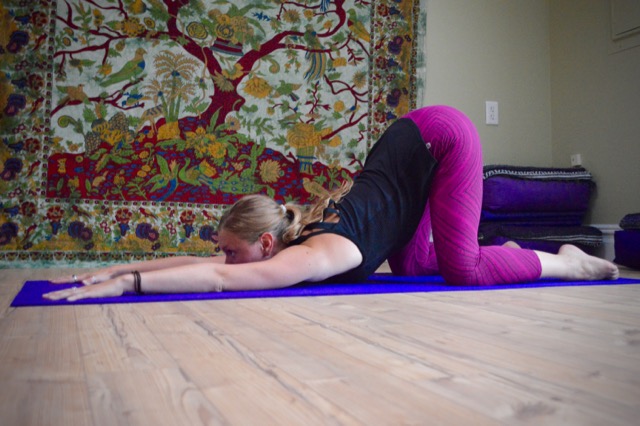
Jeanine Donohue practicing puppy pose at It Takes a Village Wellness in Port Jefferson Station, NY (Katelyn Brush)
Have you ever looked at a dog and wondered how it can be so happy all the time? Dogs can teach us a lot… including yoga. If you’re ready to try out a puppy-like stretch and relax like man’s best friend, first come into Child’s Pose. Keep the knees slightly separated with the tops of the feet flat on the floor. Keep the arms strong, reach the fingertips wide, and pull the hips up off of the heels while sliding the top body forward. Let the forehead rest on the ground. This posture can be very tough on the knees, so place a mat or blanket beneath them for extra support.
Benefits:
- Calms the mind and relieves stress, anxiety, and mild depression
- Stretches the spine, hamstrings, hips, abdominals, and shoulders
- Gently stretches the back muscles
- Strengthens the legs
Supported Headstand (Salamba Sirsasana)
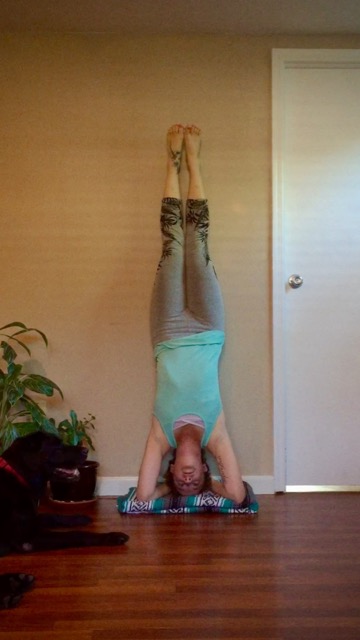
Katelyn Brush practicing a supported headstand with a blanket for neck support and dog for moral support (Katelyn Brush)
You’ve probably seen people practicing headstands all over Instagram and figured it’s for an advanced practitioner. It’s true, you should not learn headstands without supervision and you should begin with a support for your head, but headstands have many benefits for the body besides that ego boost that comes with social media “likes.” Reversing gravity’s directional pull on the body has beneficial effects on the lungs, spine, and even the skin! Headstands are good for those who suffer from scoliosis and for those who just want to decrease signs of aging in their skin.
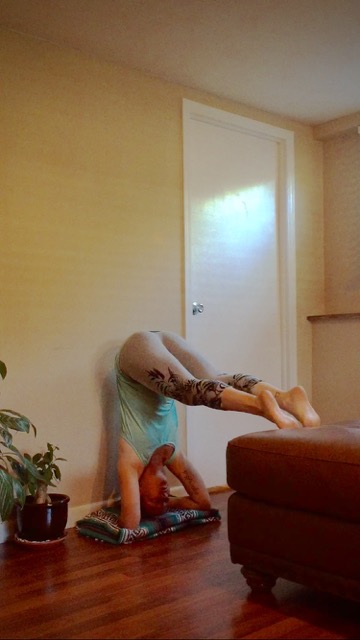
Katelyn Brush practicing a supported headstand with a foot rest for leverage (Katelyn Brush)
If you have high or low blood pressure, a back injury, or a heart condition, do not practice headstands without consulting your doctor. Speak with a certified yoga teacher about these conditions as well and ask for help as you prepare for a headstand. A certified teacher can guide you and teach you all the tips and tricks that have helped other students in the past, like using a yoga strap or elevating the legs to promote proper alignment and decrease the risk of injury.
Benefits:
- Calms the mind and relieves stress, anxiety, and mild depression
- Strengthens the arms, neck, spine, abdominal muscles, legs, and lungs
- Improves digestion and tones abdominal organs
- Therapeutic for asthma, insomnia, and sinusitis
Corpse Pose (Savasana)
Although it looks like the easiest posture, Savasana can be far from it for someone who suffers from anxiety and panic attacks. Good news is this: The more challenging the task, the greater the reward.
Savasana is the most important piece to a yoga practice. It restores the body and mind. The majority of individuals in the Western world disregard this practice because there is something more important to do, like go to a football game, write an essay, or Netflix and chill. But what is more important than healing your body and being as healthy as you can be?
Meditation allows the mind to stop rushing from one thing to the next. It calms the nervous system, taking it from the sympathetic nervous system that induces “fight or flight” to the parasympathetic that allows the body to “rest and restore.” We often live in a constant state of fight or flight, hurrying to hit deadlines and move onto the next project. The problem with this is that your body is constantly implementing a stress response system. Individuals who suffer from anxiety disorders feel this more often as they suffer from chronic stress, which has a negative effect on the immune system. Thus, people with anxiety disorders seem to be sick and tired more often than others.
Practicing meditation consistently is therapeutic for the symptoms of anxiety, including panic attacks. The more you revisit the practice, the more easily you will be able to find this state of relaxation in times of worry. Rather than just lying on the ground and trying to relax, listen to a guided meditation, such as a progressive meditation or the relaxing music of Tibetan Singing Bowls.
Benefits:
- Calms the mind and relieves stress, anxiety, and mild depression
- Therapeutic for insomnia, high or low blood pressure, headache, migraine, and fatigue
- Relaxes the central nervous system
- Improves sleep quality
-
The Truth: Why You Should Get Fit to Finish the School Year
-
How to Be Smart in Our National Parks This Summer
-
Easy Ways to Stay Fit When You’re Busy with School
-
Why I Joined and Why I Quit: A Softball Story
-
Yoga: An Energizing Practice for Beginners
-
How to Keep Your Brain Active Over Summer Vacation
-
15 Ways to Avoid Gaining the Freshman 15
-
Yoga for Detoxing from the Weekend
-
Eight Ways to Stay Fit during the Winter Months without Hitting the Gym

